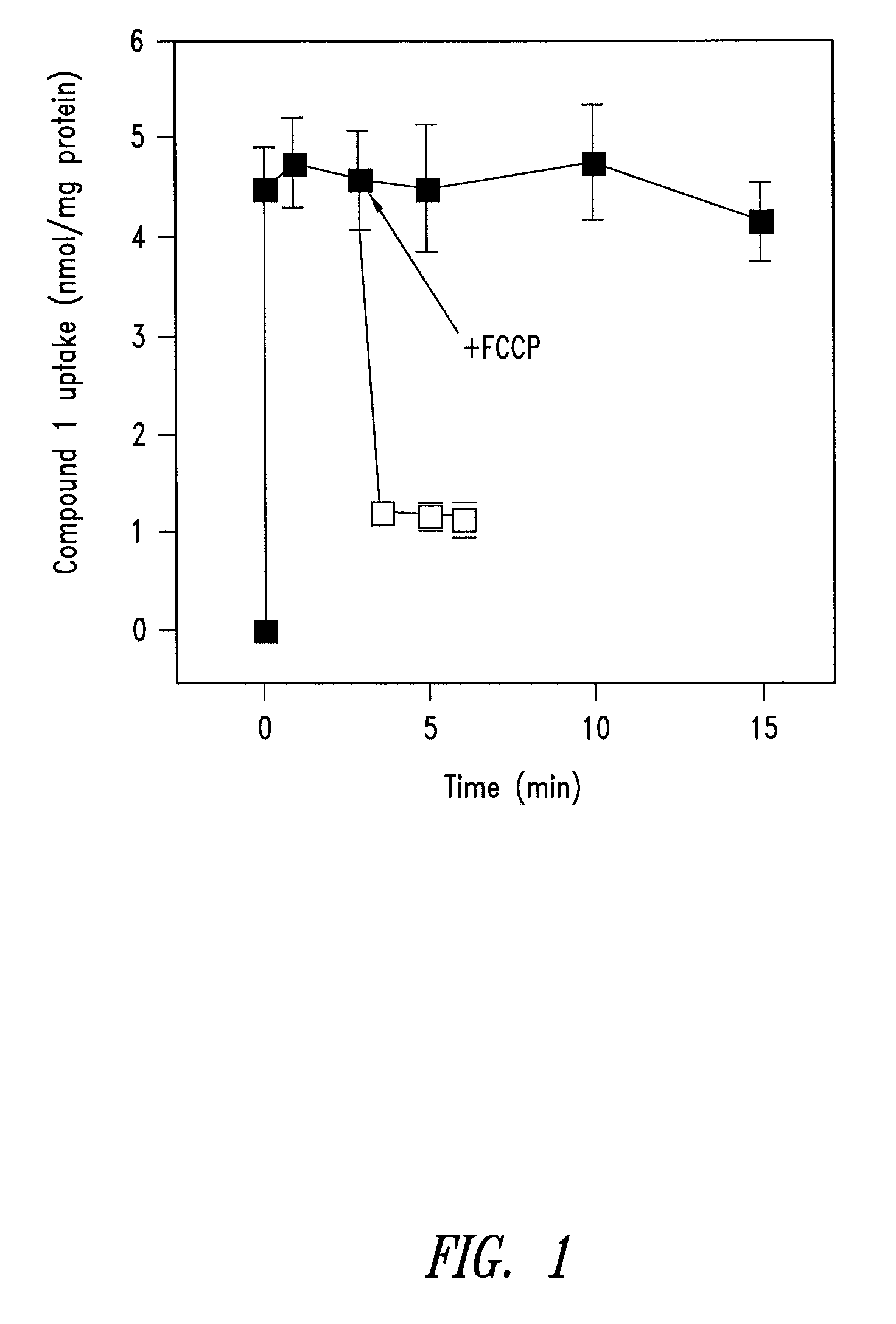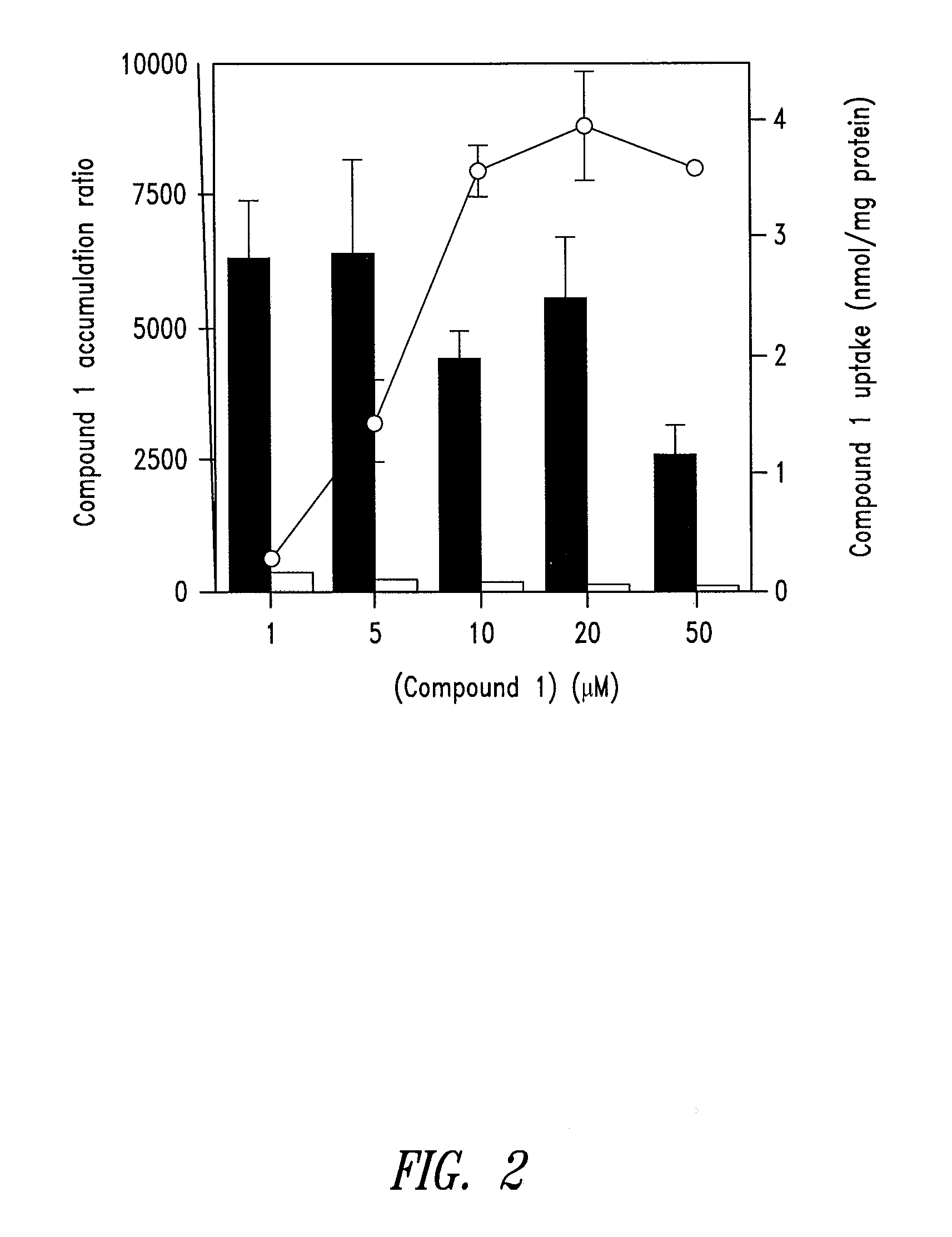Mitochondrially targeted antioxidants
a technology of antioxidants and mitochondria, applied in the field of mitochondrial targeted antioxidants, can solve the problems of low optimal effect, damage to mitochondrial defects, neural and muscle tissues with high energy demands,
- Summary
- Abstract
- Description
- Claims
- Application Information
AI Technical Summary
Benefits of technology
Problems solved by technology
Method used
Image
Examples
example 1
Experimental
1. Synthesis of a Mitochondrially-Targeted Vitamin-E Derivative (Compound 1)
[0116]The synthesis strategy for a mitochondrially-targeted vitamin-E derivative (compound 1) is as follows. The brominated precursor (compound 2) 2-(2-bromoethyl)-3,4-dihydro-6-hydroxy-2,5,7,8-tetramethyl-2H-1-benzopyran was synthesized by bromination of the corresponding alcohol as described by Grisar et al., (1995) (J Med Chem 38, 2880-2886). The alcohol was synthesized by reduction of the corresponding carboxylic acid as described by Cohen et al., (1979) (J. Amer Chem Soc 101, 6710-6716). The carboxylic acid derivative was synthesized as described by Cohen et al., (1982) (Syn Commun 12, 57-65) from 2,6-dihydroxy-2,5,7,8-tetramethylchroman, synthesized as described by Scott et al., (1974) (J. Amer. Oil Chem. Soc. 101, 6710-6716).
[0117]For the synthesis of compound 1,1 g of compound 2 was added to 8 ml butanone containing 2.5 molar equivalents of triphenylphosphine and heated at 100° C. in a se...
example 2
Synthesis of [10-(6′-ubiquinonyl)decyltriphenylphosphonium bromide] (herein referred to as “mitoquinol”)
Synthesis of Precursors
[0137]To synthesize 11-bromoundecanoic peroxide 11-bromoundecanoic acid (4.00 g, 15.1 mmol) and SOCl2 (1.6 mL, 21.5 mmol) were heated, with stirring, at 90° C. for 15 min. Excess SOCl2 was removed by distillation under reduced pressure (15 mm Hg, 90° C.) and the residue (IR, 1799 cm−1) was dissolved in diethyl ether (20 mL) and the solution cooled to 0° C. Hydrogen peroxide (30%, 1.8 mL) was added, followed by dropwise addition of pyridine (1.4 mL) over 45 min. Diethyl ether (10 mL) was added and the mixture was stirred for 1 h at room temperature then diluted with diethyl ether (150 mL) and washed with H2O (2×70 mL), 1.2 M HCl (2×70 mL), H2O (70 mL), 0.5 M NaHCO3 (2×70 mL) and H2O (70 mL). The organic phase was dried over MgSO4 and the solvent removed at room temperature under reduced pressure, giving a white solid (3.51 g). IR (nujol mull) 1810, 1782.
[0138...
example 3
Mitochondrial Antioxidant 10-(6′-ubiquinonyl) decyltriphenylphosphonium IN Chronic Hepatitis C Virus (HCV) Infection
[0152]A double-blind, randomized, parallel design trial was conducted to compare the effects of two different doses (40 mg / day or 80 mg / day) of MitoQuinone [10-(6′-ubiquinonyl)decyltriphenylphosphonium methanesulfonate] and of placebo in patients with documented history of chronic HCV infection. Participants were randomized to receive either 40 mg, 80 mg or matching placebo for 28 days. Randomization was in a 1:1:1 ratio in permutated blocks of 6. The inclusion criteria for subjects were as follows: (i) between 18 and 65 years of age; (ii) chronic hepatitis C infection (any genotype); (iii) non-responders, intolerant for treatment with current standard-of-care (PEGylated interferon plus ribavirin); (iiv) plasma ALT level of 2-10 times the upper limit of normal (ULN) at study entry; (v) Metavir Stage 0, 1, or 2 (no evidence of cirrhosis); (vi) alcohol intake of less tha...
PUM
| Property | Measurement | Unit |
|---|---|---|
| membrane potential | aaaaa | aaaaa |
| mitochondrial membrane potential | aaaaa | aaaaa |
| pH | aaaaa | aaaaa |
Abstract
Description
Claims
Application Information
 Login to View More
Login to View More - R&D
- Intellectual Property
- Life Sciences
- Materials
- Tech Scout
- Unparalleled Data Quality
- Higher Quality Content
- 60% Fewer Hallucinations
Browse by: Latest US Patents, China's latest patents, Technical Efficacy Thesaurus, Application Domain, Technology Topic, Popular Technical Reports.
© 2025 PatSnap. All rights reserved.Legal|Privacy policy|Modern Slavery Act Transparency Statement|Sitemap|About US| Contact US: help@patsnap.com



